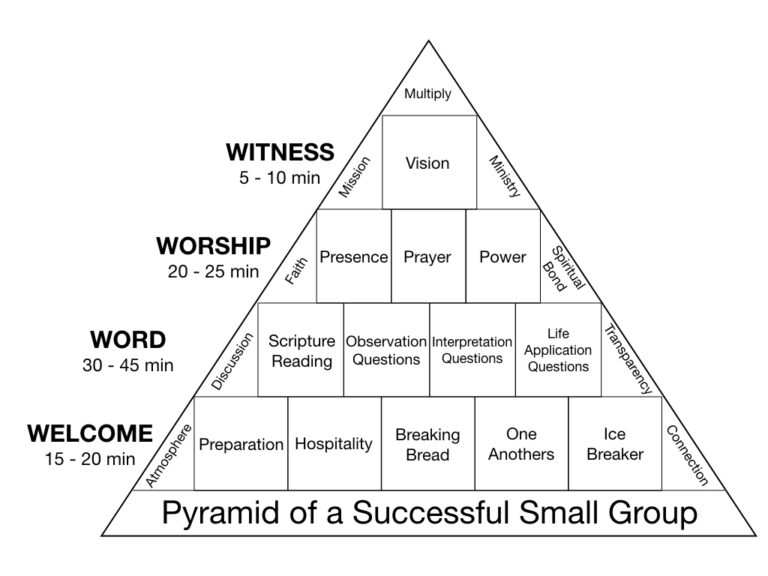This simple small group agenda is based on seven principles from Acts 2:42-47, Acts 5:42 and Acts 6:7. The seven principles are as follows…
- House-to-House Gatherings – smaller than the temple courts gatherings and an expression of hospitality.
- Devoted to the Apostles’ Doctrine – interacting with the Word of God in a communal setting.
- Devoted to Fellowship – experiencing the 59 one anothers of the NT.
- Devoted to Breaking Bread – meals, snacks and communion together.
- Devoted to Prayer – encountering His presence and power.
- Living on Mission – being a witness together through serving, outreach and evangelism.
- Experiencing Multiplication – cultivating kingdom laborers and launching new communities.
These seven principles represent settings, practices and the fruit that is produced as a result. They can be touched upon in a weekly home group through a simple small group agenda known as The Four W’s: Welcome, Word, Worship and Witness. I did not come up with these but I have revised them slightly. Ralph W. Neighbour originally developed the concept of The Four W’s.
Welcome
(15-20 minutes)
The Welcome time helps people get connected to each other as they arrive. A meal or snacks and upbeat Christian music can create an irresistible atmosphere (See also Creating an Irresistible Environment). When we have provided the opportunity for a meal, we offer it as an option 30 minutes before the starting time.
This window as well as the time hanging out after dismissal are the key times for believers to experience the 59 “one anothers” of the New Testament. For more on this see The 59 One Anothers of the Bible.
The group should be small enough and healthy enough for everyone to fellowship. It should be illegal for a person to show up to a small group and experience isolation.
Before you move into the Word segment, you can begin to transition the Welcome time by starting the meeting with an Ice Breaker. For more on this see Tons of Free Ice Breakers and Why They’re Effective.
Word
(30-45 minutes)
The Word time should complement the corporate teaching time in the weekend service (not try to duplicate it). People need to grow in the Word of God through hearing (corporate teaching) and dialogue (small group). See my article Fully Developed Disciples for more on that.
This can be achieved in a small group through a Word-centered conversation. If the Word of God is a seed then an interactive Bible discussion can plow the fallow ground of a person’s heart through deepening, open-ended questions (See Small Group Discussion Questions That Go Deep as well). This process can be remembered with the acronym for SOIL…
S – Scripture reading and focus (this is also the spot for a short video teaching if you’re using video curriculum)
O – Observation questions about the passage.
I – Interpretation questions about the passage.
L – Life application questions about the passage.
Facilitating skills, listening, vulnerability and navigating personalities are keys to an effective Word segment (See Five Facets of Facilitating With Finesse) .
The goal here is for people to grow in their knowledge of the Word and develop their own language for discussing their faith. Transformation occurs through revelation and transparency with the community of believers.
Worship
(20-25 minutes)
Some prefer to have their worship time before the Word segment and end their meeting with prayer. Whatever works best for your group or that night’s purpose is what you should do. I prefer to lead into the time of intercession with worship.
First I ask for and write down any prayer requests from the group. We then seek God’s face in praise and worship for five to eight minutes before bringing our prayer requests to His throne. It’s an open time where anyone can lead out.
The worship time releases presence, prayer and power in the midst of the group in a way that builds up each other’s faith and spiritually bonds everyone together.
Witness
(5-10 minutes)
As you close your gathering you can share vision for the future direction of the group. This is vital to keeping the group looking outward through mission, ministry and multiplication. Serving opportunities and reaching out to unbelievers as a group promotes a balanced discipleship pattern. Multiplication of the group through the cultivation of laborers and launching of a new group should be discussed for the group to continue to grow into a kingdom mindset (See also 5 Ways to Multiply a Small Group).
A typical small group meeting should last between 90 minutes to two hours. We’ve had people at our house for over four hours, but we’ve always dismissed the formal meeting within two hours. After the dismissal, we welcome people to stay as long as they want but that may differ for you.
To dive in deeper on these concepts I highly recommend Joel Comiskey’s book How to Lead an Effective Cell Group Meeting.
In the likeness of John Wooden’s Pyramid of Success, I have created a Pyramid for a Successful Small Group Gathering below…
This article originally appeared here.


